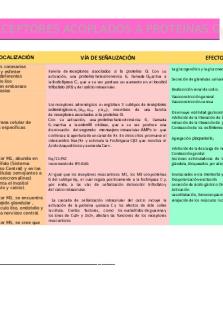Receptor Theory 2 – Jenni Harvey PDF

| Title | Receptor Theory 2 – Jenni Harvey |
|---|---|
| Course | Quantitative Pharmacology |
| Institution | University of Dundee |
| Pages | 6 |
| File Size | 369 KB |
| File Type | |
| Total Downloads | 113 |
| Total Views | 138 |
Summary
Part of the Receptor Theory series of lectures by Dr Harvey....
Description
Receptor Theory 2 – Jenni Harvey
But Stephenson found drugs (eg. n-butyl trimethylammonium) acting as muscarinic R agonists in guinea pig ileum, where the ratio of agonist concentrations for 80% compared with 20% responses was much lower than 16 (i.e. concentration-response curves were much steeper than predicted by the occupancy equation). Led to his modification of occupancy theory to incorporate influence of “spare receptors” upon agonist action Stephenson hypothesised that an agonist produces a response by applying a STIMULUS (S) to a tissue Size of the STIMULUS was thought to depend on two factors: (1) Agonist FRACTIONAL OCCUPANCY within the receptor population (2) Agonist EFFICACY (e) -the ability of the drug to produce an element of response when bound to each receptor. “bounce per ounce of agonist-bound receptor”.
Efficacy was introduced by Stephenson (1956) to describe the way in which agonists vary in the response they produce even when they occupy the same number of receptors. High-efficacy agonists produce maximal responses while occupying a relatively low proportion of receptors; Lower efficacy agonists cannot activate receptors to the same degree and may not produce the same maximal response even when they occupy the entire receptor population, thereby behaving as partial agonists.
Stimulus and Efficacy MATHEMATICAL TREATMENT
S = e x = e x
fractional occupancy [D] [D] + Kd Divide top and bottom of
ratio by Kd, to rewrite equation as:
S =
e x
([D]/Kd) ([D]/Kd) +
1 When a very high proportion of spare receptors are present, agonist concentrations much lower than Kd would be required to produce responses up to the max response; in this case where [D]...
Similar Free PDFs

Receptor Theory 2 – Jenni Harvey
- 6 Pages

Pharmacology receptor theory 11
- 6 Pages

William Harvey
- 8 Pages

Receptor Tyrosine kinases
- 4 Pages

Image Receptor Placement
- 4 Pages

Rehabilitation - Annelie harvey
- 4 Pages

Harvey Sanchez 334
- 10 Pages

MGF741 Summary Graham and Harvey
- 3 Pages

Harvey Norman - business analysis
- 10 Pages

Riassunto Città ribelli Harvey
- 6 Pages

Receptor Acoplado A ProteÍna G
- 4 Pages

Brief - Harvey v. Dow
- 3 Pages

Task 3 - Harvey Meza
- 17 Pages
Popular Institutions
- Tinajero National High School - Annex
- Politeknik Caltex Riau
- Yokohama City University
- SGT University
- University of Al-Qadisiyah
- Divine Word College of Vigan
- Techniek College Rotterdam
- Universidade de Santiago
- Universiti Teknologi MARA Cawangan Johor Kampus Pasir Gudang
- Poltekkes Kemenkes Yogyakarta
- Baguio City National High School
- Colegio san marcos
- preparatoria uno
- Centro de Bachillerato Tecnológico Industrial y de Servicios No. 107
- Dalian Maritime University
- Quang Trung Secondary School
- Colegio Tecnológico en Informática
- Corporación Regional de Educación Superior
- Grupo CEDVA
- Dar Al Uloom University
- Centro de Estudios Preuniversitarios de la Universidad Nacional de Ingeniería
- 上智大学
- Aakash International School, Nuna Majara
- San Felipe Neri Catholic School
- Kang Chiao International School - New Taipei City
- Misamis Occidental National High School
- Institución Educativa Escuela Normal Juan Ladrilleros
- Kolehiyo ng Pantukan
- Batanes State College
- Instituto Continental
- Sekolah Menengah Kejuruan Kesehatan Kaltara (Tarakan)
- Colegio de La Inmaculada Concepcion - Cebu


